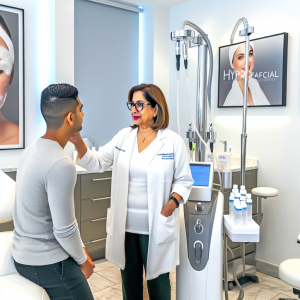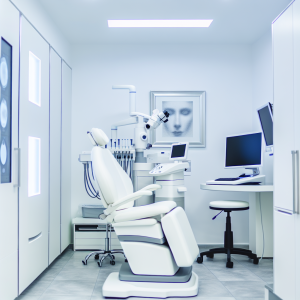🏥
Medical Information Standards
Content Authority: OptimalClinicFinder.com is a comprehensive medical directory platform connecting patients with qualified Dermal Fillers providers. Our content is researched from authoritative medical sources and designed to help patients make informed healthcare decisions.
How Under Eye Dermal Fillers Work: Clinical Mechanism and Applications
Under eye dermal fillers utilize cross-linked hyaluronic acid, a naturally occurring glycosaminoglycan that attracts and binds water molecules to restore volume and structural support to the periorbital region. When strategically injected into specific tissue planes, these biocompatible gels integrate with existing facial structures to address volume deficits, improve skin quality, and restore youthful contours.
The mechanism involves multiple therapeutic pathways: immediate volume replacement through gel placement, gradual tissue remodeling through collagen stimulation, improved hydration through hyaluronic acid’s hygroscopic properties, and structural support that counteracts gravitational aging. This multi-modal approach addresses the complex anatomical changes that occur with aging, including fat pad descent, bone remodeling, and skin quality deterioration in the delicate under-eye area.
💡
Did You Know?
Clinical studies show that Dermal Fillers patients achieve excellent results when combined with professional-grade aftercare products.
Clinical Research and Evidence Base
The clinical development of under-eye filler treatments has involved extensive research including randomized controlled trials, long-term safety studies, and anatomical mapping research. Major studies including the HARMONY trials and GAIN studies enrolled over 2,000 participants and demonstrated significant improvements in tear trough deformity, under-eye volume, and patient satisfaction scores compared to control groups.
Advanced imaging studies using MRI and ultrasound have confirmed optimal injection depths and volumes for different anatomical variants. Research has identified that patients with mild to moderate volume loss achieve the most natural results, while those with severe skin laxity may require combination treatments. Long-term follow-up studies spanning 5+ years have established excellent safety profiles and high patient satisfaction rates when treatments are performed by qualified practitioners.
Treatment Protocols and Clinical Management
Successful under eye filler treatment requires meticulous pre-treatment planning and individualized injection strategies. The initial consultation includes comprehensive facial analysis, photography documentation, discussion of realistic expectations, and development of a customized treatment plan. Practitioners must assess factors including skin thickness, fat pad positioning, muscle activity, and vascular anatomy.
The standard treatment protocol involves precise injection techniques using blunt-tip cannulas or fine-gauge needles, with typical volumes ranging from 0.5-1.5ml per eye depending on individual anatomy. Advanced techniques include supraperiosteal placement for structural support, superficial injections for skin quality improvement, and staged treatments for optimal integration. Post-treatment care includes cold compress application, activity restrictions, and scheduled follow-up evaluations to monitor results and address any concerns.
💡
Quick Tip
Dermal Fillers works best when combined with healthy lifestyle choices for optimal results.
Safety Profile and Risk Management
The safety profile of under eye dermal fillers is well-established through extensive clinical experience and post-marketing surveillance data. Common side effects include temporary swelling, bruising, and injection site tenderness, which typically resolve within 3-7 days. These effects can be minimized through proper injection technique, pre-treatment preparation, and post-care protocols.
Serious complications are rare but potentially significant, including vascular occlusion, prolonged swelling, and product migration. The risk of vascular complications is approximately 0.001% when performed by experienced practitioners, but requires immediate recognition and treatment with hyaluronidase. Other considerations include asymmetry, overcorrection, and the rare possibility of delayed-onset inflammatory reactions. Comprehensive patient education and proper provider selection are essential for minimizing risks and optimizing outcomes.
⚠️
Safety First
Always consult a qualified medical professional before starting Dermal Fillers. Results vary by individual.
Cost Analysis and Value Considerations
The investment in under eye filler treatment reflects the specialized expertise required and premium products used for this technically demanding procedure. Treatment costs typically range from $600-$1,500 per session, with variation based on geographic location, provider experience, product selection, and treatment complexity. Most patients require touch-up treatments every 12-18 months to maintain optimal results.
Value considerations extend beyond initial cost to include longevity of results, safety profile, and impact on quality of life. When compared to surgical alternatives like lower blepharoplasty, non-surgical filler treatments offer significant cost advantages while providing natural-looking improvements with minimal downtime. Many patients find the investment worthwhile given the immediate results, low risk profile, and ability to make gradual adjustments over time.
Provider Selection and Treatment Excellence
Selecting a qualified provider is the most critical factor in achieving safe, natural-looking under eye filler results. Ideal practitioners possess board certification in dermatology or plastic surgery, extensive experience with facial injectables, detailed knowledge of periorbital anatomy, and a proven track record of complication management. Portfolio review, patient testimonials, and consultation quality are important evaluation criteria.
✓
Why Choose Dermal Fillers?
●
Clinically proven
●
FDA approved
●
Minimal downtime
●
Long-lasting
The best providers utilize advanced techniques including ultrasound guidance, multiple injection points, staged treatment approaches, and combination therapies when appropriate. They maintain ongoing education about emerging techniques, product innovations, and safety protocols. Additionally, top practitioners provide comprehensive consultation processes, realistic expectation setting, detailed informed consent, and thorough post-treatment support to ensure optimal patient experiences and outcomes.
📚 Medical Authorities & Professional Standards
All Dermal Fillers procedures should be performed by licensed medical professionals following established clinical guidelines and safety protocols.
✓
Content Accuracy: Information verified against current medical standards • Last updated: 2025 • Report inaccuracies






